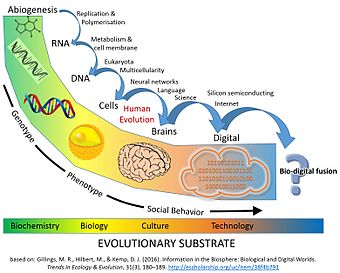
Life is a quality that distinguishes matter that has biological processes, such as signaling and self-sustaining processes, from matter that does not, and is defined by the capacity for growth, reaction to stimuli, metabolism, energy transformation, and reproduction. Various forms of life exist, such as plants, animals, fungi, protists, archaea, and bacteria. Biology is the science that studies life.
A meme is an idea, behavior, or style that spreads by means of imitation from person to person within a culture and often carries symbolic meaning representing a particular phenomenon or theme. A meme acts as a unit for carrying cultural ideas, symbols, or practices, that can be transmitted from one mind to another through writing, speech, gestures, rituals, or other imitable phenomena with a mimicked theme. Supporters of the concept regard memes as cultural analogues to genes in that they self-replicate, mutate, and respond to selective pressures. In popular language, a meme may refer to an Internet meme, typically an image, that is remixed, copied, and circulated in a shared cultural experience online.
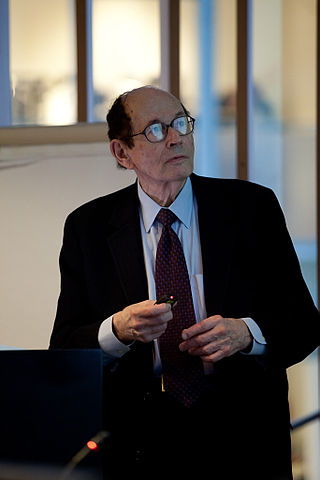
Neural Darwinism is a biological, and more specifically Darwinian and selectionist, approach to understanding global brain function, originally proposed by American biologist, researcher and Nobel-Prize recipient Gerald Maurice Edelman. Edelman's 1987 book Neural Darwinism introduced the public to the theory of neuronal group selection (TNGS) – which is the core theory underlying Edelman's explanation of global brain function.
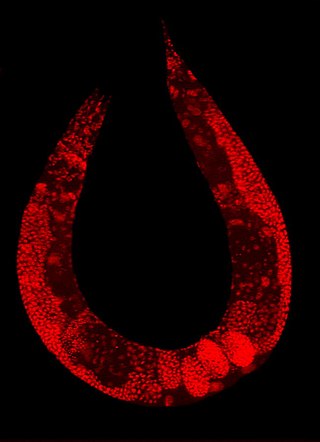
A multicellular organism is an organism that consists of more than one cell, in contrast to unicellular organism. All species of animals, land plants and most fungi are multicellular, as are many algae, whereas a few organisms are partially uni- and partially multicellular, like slime molds and social amoebae such as the genus Dictyostelium.
Eörs Szathmáry is a Hungarian theoretical evolutionary biologist at the now-defunct Collegium Budapest Institute for Advanced Study and at the Department of Plant Taxonomy and Ecology of Eötvös Loránd University, Budapest. He is the co-author with John Maynard Smith of The Major Transitions in Evolution, a seminal work which continues to contribute to ongoing issues in evolutionary biology. He is a member of the Batthyány Society of Professors.
The Major Transitions in Evolution is a book written by John Maynard Smith and Eörs Szathmáry.
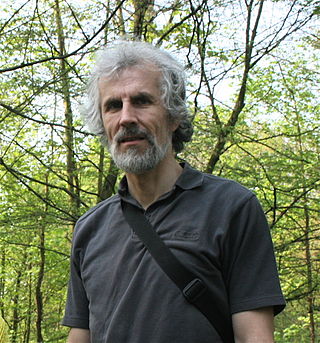
Francis Paul Heylighen is a Belgian cyberneticist investigating the emergence and evolution of intelligent organization. He presently works as a research professor at the Vrije Universiteit Brussel, where he directs the transdisciplinary research group on "Evolution, Complexity and Cognition" and the Global Brain Institute. He is best known for his work on the Principia Cybernetica Project, his model of the Internet as a global brain, and his contributions to the theories of memetics and self-organization. He is also known, albeit to a lesser extent, for his work on gifted people and their problems.

Valentin Fyodorovich Turchin was a Soviet and American physicist, cybernetician, and computer scientist. He developed the Refal programming language, the theory of metasystem transitions and the notion of supercompilation. He was as a pioneer in artificial intelligence and a proponent of the global brain hypothesis.
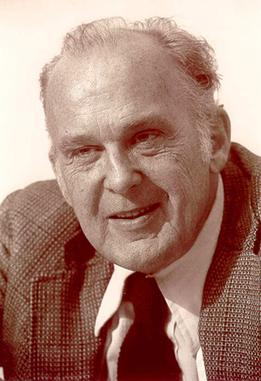
Donald Thomas Campbell was an American social scientist. He is noted for his work in methodology. He coined the term evolutionary epistemology and developed a selectionist theory of human creativity. A Review of General Psychology survey, published in 2002, ranked Campbell as the 33rd most cited psychologist of the 20th century.

Biological organisation is the organisation of complex biological structures and systems that define life using a reductionistic approach. The traditional hierarchy, as detailed below, extends from atoms to biospheres. The higher levels of this scheme are often referred to as an ecological organisation concept, or as the field, hierarchical ecology.
The evolution of biological complexity is one important outcome of the process of evolution. Evolution has produced some remarkably complex organisms – although the actual level of complexity is very hard to define or measure accurately in biology, with properties such as gene content, the number of cell types or morphology all proposed as possible metrics.
Principia Cybernetica is an international cooperation of scientists in the field of cybernetics and systems science, especially known for their website, Principia Cybernetica. They have dedicated their organization to what they call "a computer-supported evolutionary-systemic philosophy, in the context of the transdisciplinary academic fields of Systems Science and Cybernetics".
Ephemeralization, a term coined by R. Buckminster Fuller in 1938, is the ability of technological advancement to do "more and more with less and less until eventually you can do everything with nothing," that is, an accelerating increase in the efficiency of achieving the same or more output while requiring less input. The application of materials and technology in modern cell phones, compared to older computers and phones, exemplify the concepts of Ephemeralization whereby technological advancement can drive efficiency in the form of fewer materials being used to provide greater utility. Fuller's vision was that ephemeralization, through technological progress, could result in ever-increasing standards of living for an ever-growing population. The concept has been embraced by those who argue against Malthusian philosophy.

The global brain is a neuroscience-inspired and futurological vision of the planetary information and communications technology network that interconnects all humans and their technological artifacts. As this network stores ever more information, takes over ever more functions of coordination and communication from traditional organizations, and becomes increasingly intelligent, it increasingly plays the role of a brain for the planet Earth.

Universal Darwinism, also known as generalized Darwinism, universal selection theory, or Darwinian metaphysics, is a variety of approaches that extend the theory of Darwinism beyond its original domain of biological evolution on Earth. Universal Darwinism aims to formulate a generalized version of the mechanisms of variation, selection and heredity proposed by Charles Darwin, so that they can apply to explain evolution in a wide variety of other domains, including psychology, linguistics, economics, culture, medicine, computer science, and physics.

Cliff Joslyn is an American mathematician, cognitive scientist, and cybernetician. He is currently the Chief Knowledge Scientist and Team Lead for Mathematics of Data Science at the Pacific Northwest National Laboratory in Seattle, Washington, US, and visiting professor of Systems Science at Binghamton University (SUNY).

The term chemoton refers to an abstract model for the fundamental unit of life introduced by Hungarian theoretical biologist Tibor Gánti. Gánti conceived the basic idea in 1952 and formulated the concept in 1971 in his book The Principles of Life. He suggested that the chemoton was the original ancestor of all organisms.

In chemistry, a hypercycle is an abstract model of organization of self-replicating molecules connected in a cyclic, autocatalytic manner. It was introduced in an ordinary differential equation (ODE) form by the Nobel Prize in Chemistry winner Manfred Eigen in 1971 and subsequently further extended in collaboration with Peter Schuster. It was proposed as a solution to the error threshold problem encountered during modelling of replicative molecules that hypothetically existed on the primordial Earth. As such, it explained how life on Earth could have begun using only relatively short genetic sequences, which in theory were too short to store all essential information. The hypercycle is a special case of the replicator equation. The most important properties of hypercycles are autocatalytic growth competition between cycles, once-for-ever selective behaviour, utilization of small selective advantage, rapid evolvability, increased information capacity, and selection against parasitic branches.

Artificial life is a field of study wherein researchers examine systems related to natural life, its processes, and its evolution, through the use of simulations with computer models, robotics, and biochemistry. The discipline was named by Christopher Langton, an American theoretical biologist, in 1986. In 1987 Langton organized the first conference on the field, in Los Alamos, New Mexico. There are three main kinds of alife, named for their approaches: soft, from software; hard, from hardware; and wet, from biochemistry. Artificial life researchers study traditional biology by trying to recreate aspects of biological phenomena.
Megaevolution describes the most dramatic events in evolution. It is no longer suggested that the evolutionary processes involved are necessarily special, although in some cases they might be. Whereas macroevolution can apply to relatively modest changes that produced diversification of species and genera and are readily compared to microevolution, "megaevolution" is used for great changes. Megaevolution has been extensively debated because it has been seen as a possible objection to Charles Darwin's theory of gradual evolution by natural selection.
